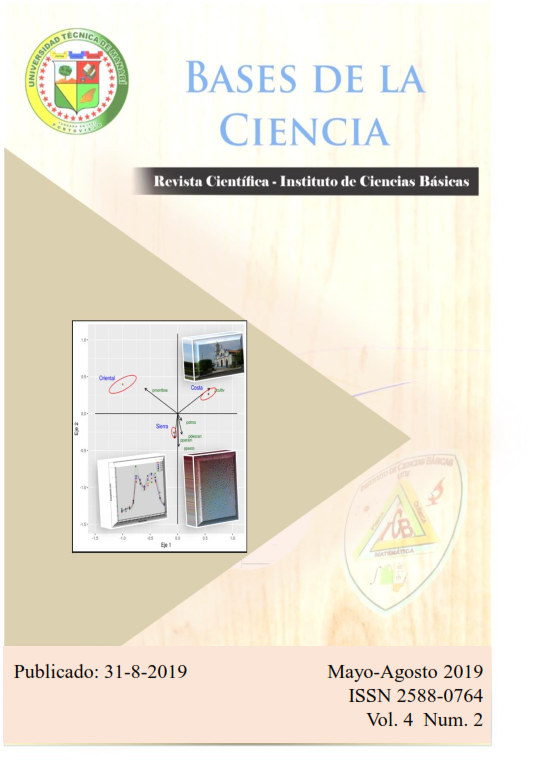Theoretical aspects of the MANOVA-BIPLOT and their application to land uses in the ESPAC-2016
Theoretical aspects of the MANOVA-BIPLOT and their application to land uses in the ESPAC-2016
DOI:
https://doi.org/10.33936/rev_bas_de_la_ciencia.v4i2.4236Keywords:
Regiones del Ecuador, usos del suelo, MANOVA, Biplot.Abstract
Some theoretical aspects are presented about the relationship between the classic techniques of MANOVA and Biplot, which are the basis of the MANOVA - Biplot graph. Applying this technique to a set of data concerning to the uses of the land in the three major regions defined by Ecuador, their differences are investigated in order to achieve a synthetic characterization that can be used to compare them statistically and to improve appropriately the decision process. The eastern region is characterized by the use of its soil predominantly in mountains, natural and artificial forests, while the coastal region by permanent crops, transients and fallows, and the region of the sierra by the remaining pastures, breaks, barren lands and others. An illustration of the results is presented that shows the great value of synthesis that the proposed statistical technique has, including the R code that produces it.
Downloads
References
Amaro, I. R., Vicente-Villardón, J. L. & Galindo-Villardón, M. P. (2008), Contribuciones al Manova-biplot: regiones de confianza alternativas. Revista Investigación Operacional, 29(3), 231-241.
Cuadras, C. M. (2014). Nuevos Métodos de Análisis Multivariante. Barcelona, España: CMC Editions.
Gabriel, K.R. (1972): Analysis of meteorological data by means of canonical decomposition and Biplots. Journal of Applied Meteorology, 11, 1071-1077.
Gabriel, K. R. (1995): MANOVA Biplots for two-way contingency tables. En: Recent Advances in Descriptive Multivariate Analysis. (W. KRZANOWSKI, ed.). Clarendon Press, Oxford, 227-268.
García-Talegón, J., Iñigo, A. C. & Vicente-Palacios, V. (2016), A laboratory simulation of desalting on calcareous building stone with wet sepiolite. Environmental Earth Sciences, 925(75), 1-15.
Gower, J. C. y Hand, D. J. (1996): Biplots. Chapman and Hall, London.
Iñigo, A. C., García-Talegón, J. & Vicente-Tavera, S. (2014), Canonical biplot statistical analysis to detect the magnitude of the effects of phosphates crystallization aging on the color in siliceous conglomerates. Research and Application, 39(1), 82-87.
Iñigo, A. C., García-Talegón, J. Vicente-Tavera, S., Casado-Marín, S. & Martín-Gonzales, S. (2017), Multivariate analyses of soluble salts responsible for pathologies in granites of the roman aqueduct of Segovia, Spain. International Journal of Conservation Science, 8(1), 59-66.
Iñigo, A. C., Vicente-Tavera, S. & Rives, V. (2004), Manova-biplot statistical analysis of the effect of artificial ageing (freezing/thawing) on the colour of treated granite stones. Color Research and Applications, 29(2), 115-120.
INEC (2017), Encuesta de Superficie y Producción Agropecuaria Continua ESPAC 2016: Informe Ejecutivo, Instituto Nacional de Estadística y Censos, Quito, Ecuador. Recuperado de: www.ecuadorencifras.gob.ec.
Mardia, K. V., Kent, J. T., Bibby, J.M. (1979). Multivariate Analysis. Academic press. London, RU.
Morrison, D. F. (1978). Multivariate Statistical Methods. McGraw-Hill. Londres, RU.
Nieto, A. B., Galindo, M. P., Leiva, V. & Vicente-Galindo, P. (2014). A methodology for biplots based on bootstrapping with R. Revista Colombiana de Estadística, 37(2), 367-397.
R Core Team. (2017). R: A Language and Environment for Statistical Computing, R. Vienna, Austria: Foundation for Statistical Computing. Recovered from: https://www.R-project.org/
Varas, M. J., Vicente-Tavera, S., Molina, E. & Vicente-Villardón, J. L. (2005). Role of canonical biplot method in the study of building stones: an example from Spanish monumental heritage. Environmetrics pp. 1-15.
Vicente-Villardón, J. L. (1992). Una alternativa a las técnicas factoriales basada en una generalización de los métodos Biplot. Tesis Doctoral. Universidad de Salamanca.

























